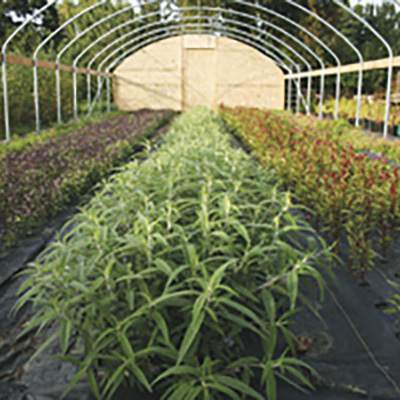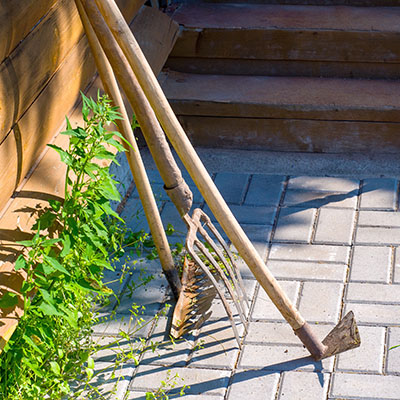I believe too many growers emphasize mechanical weed control as THE solution to their weed problems. Most of the organic vegetable producers I know are always looking for new cultivating tools: finger weeders, flex tine harrow weeders, torsion weeders, computer-controlled, and even robot cultivators (for real!). Upon first glance, it seems that having all of these tools or machines would be ideal, given that each one works precisely and effectively under very specific field conditions. Trade shows I attend are always lined up with growers eager to acquire new technologies for their farms. But for many smaller-scale market growers, such sophisticated tools are not currently available (at least not to my knowledge), and this might be a good thing as it enables us to look elsewhere for weed control solutions.
Here are several worthwhile ideas that have helped us over the years.
Don’t weed, cultivate
I was once at an organic farming conference where an experienced grower with more than 20 seasons under his belt was asked to name the top five most problematic weeds on his farm. After quickly naming two, he stalled for some time, causing an awkward silence in the room. After a few moments, he admitted that he didn’t know the names of his weeds because he never let them grow big enough to identify them! That veteran grower made a strong impression on me, and I’ve been following the mantra of cultivating ever since.
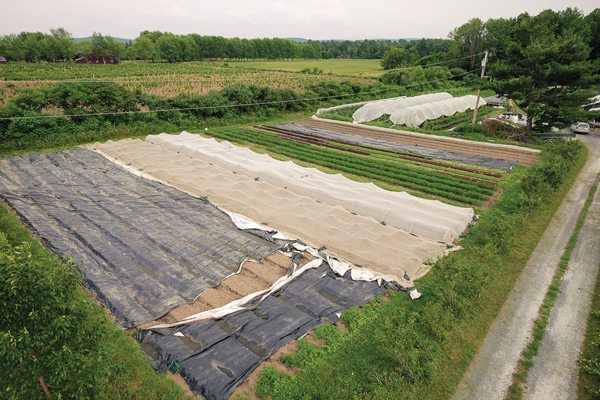
Soil-covering tarps are about as effective at fighting weeds as a short cover crop in a conventional vegetable rotation, but they can be set up in one go. They work immediately and quickly, and are the perfect fit for the intensive market gardening model.
The bigger the weeds get, the more difficult they are to control. Therefore, the most effective way to deal with weeds is to get to them before they get established, at the stage when lightly disturbing the soil is enough to kill them. In an ideal maintenance schedule, beds are hoed every 10 to 15 days, especially during the months of June and July, when weeds are persistent and in direct competition with crops. It’s also important to cultivate under good circumstances; if the soil is wet, any weeds hoed may re-root and the work will have accomplished little. The best time is on a dry, sunny day — and so that’s when we plan this chore.
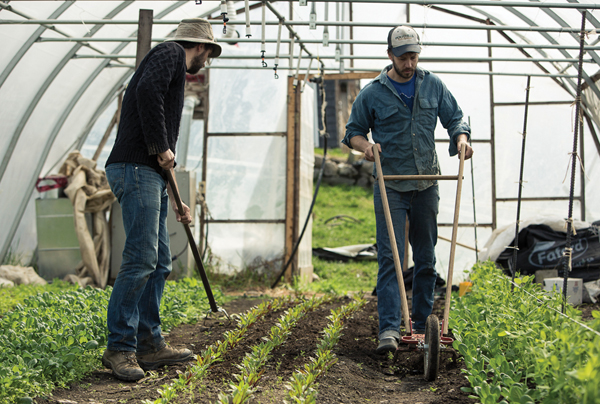
Light and precise hoes, designed for shallow cultivation and for an upright working position, are the tools of choice for weeding in the market garden. This technique is a world away from the tedious work of yanking out weeds on your hands and knees. All photos courtesy of J.M. Fortier.
In times of prolonged wet weather, it may be tempting to go out and cultivate anyway, but we’ve learned that it serves no purpose. One might as well advance other jobs ahead of time and be ready when the sun comes out. We’ve also learned to keep our hoes well sharpened. Doing so makes a big difference in terms of efficiency, especially when hoeing perennial weeds past the cotyledon stage. You want the hoe not only to disturb the weed, but to slice the roots of the uprooted plants. We sharpen our blades once a week with an electric grinder and carry a handheld carbide sharpener.
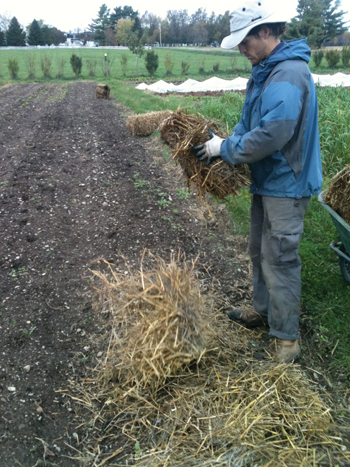
Below: The straw we use to cover our garlic during the winter is made from first-cut fall rye. This straw is harvested at the beginning of the summer, when few weeds have gone to flower; it’s therefore more likely to be clean and free of herbicides, even if produced by a conventional farmer.
Letting weeds go to seed increases weed pressure for the following year.
In our area, Galinsoga is particularly difficult to get rid of once it establishes itself. Keep in mind that weeds as such can produces about 10,000 seeds per plant! Failure to weed even once can lead to invasions that last many seasons.

“Too many growers consider hoeing to be a treatment for weeds, and thus they start too late. Hoeing should be understood as a means of prevention… Large weeds are competition for both the crops and the grower.”— Eliot Coleman, The New Organic Grower, 1989
Weeding with tarps
Over the years, we evolved our cropping system relying on UV-treated silage tarps to prepare our permanent beds in compliance with a minimal tillage technique, but also to keep weeds in check.
Keeping your soil covered is the best way to limit the surface area on which weeds can establish themselves. But even more interestingly, black tarps do an especially good job of diminishing weed pressure on subsequent crops. The explanation is simple: weeds germinate in the warm, moist conditions created by the tarp but are then killed by the absence of light. This weeding technique, described as “occultation,” is widely use by organic growers I’ve visited in Europe.
This passive and efficient practice takes care of part of the weeding chores while we are getting work done elsewhere in the fields. Try it for yourselves, an you’ll see how clever this practice is.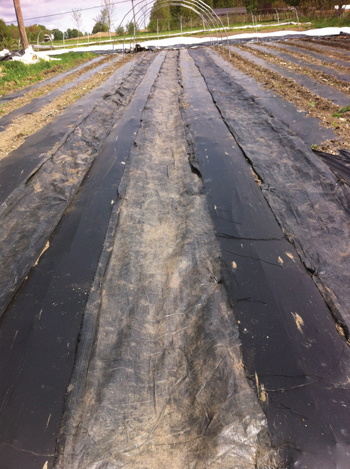
Inorganic mulches can reduce the weeding workload to one or two early rounds of hand-pulling weeds. For crops that will stay awhile in the garden, the effort and investment required to lay them out it is definitely worthwhile.
The Stale Seedbed Technique
The stale seedbed technique (also called false seed planting) consists of preparing seedbeds a few weeks prior to the seeding date, allowing weed seeds in the top 2 inches of the soil to germinate. When ready to seed, whether directly or by transplanting, the soil surface is then shallowly worked again, effectively destroying emerging weeds. The result is that the crop can get a head start over the weeds yet to come, and the difference between beds that have received the treatment and those that have not is striking.
For this technique to be effective, a few things must be considered. First, it’s important to let the beds go stale long enough for the weed seeds to germinate. In our gardens, we prepare them 10 to 15 days in advance and cover the bed with floating row covers. To avoid missing the boat when preparing flame weeding we always throw on a handful of seeds that are known to germinate earlier than the main crop at the head of the seedbed. A patch of tiny radish plants signals that beets are about to pop up, while tiny beet tips indicate that the carrot crop is imminent.
Second, the destruction of the emerging weeds must be done in such a way as to not bring up weed seeds that haven’t germinated. A quick surface passage with our power harrow does a great job, but using a wheel hoe works just as well. To avoid any stirring of the soil and guarantee that buried weed seeds will not come up, a flame-weeder can also be used. Since this simple technique gives tangible results, we try to use it as much as possible, especially for direct-seeded crops. To ensure proper results, we have systemized the practice by integrating bed preparation into our crop planning calendar.
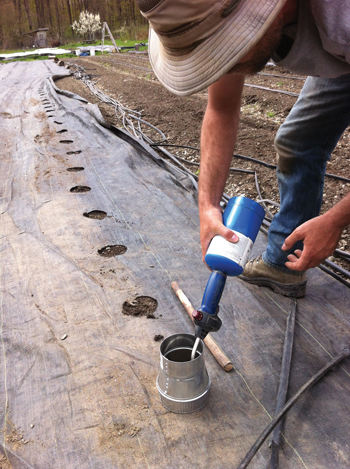
Landscape fabric (we refer to it as “geotextile”) is reusable and durable. Ours are in their sixth season and show little or no wear. They come in rolls of a width that will cover both beds and pathways. To make the holes, we use a small propane torch (it works best with a fine-tipped nozzle).
Flame weeding in pre-emergence
Flame weeding is a technique in which weeds are killed by burning them with a blowtorch. Actually, the term “burning” is a bit misleading: the weeds are not burned to a crisp but rather subjected to a form of heat shock that causes damage at the cellular level. In order for flame weeding to be successful, two conditions must be present: the flames of the torch must actually make contact with the soil, and the weeds must be small enough that a single second of flame exposure is enough to kill them (i.e., between the cotyledon stage and the first true leaf). It’s also important to flame over a very smooth seedbed, since irregularities in the surface of the soil can sometimes deflect heat from the flame weeder, giving some protection to weed seedlings.
As I mentioned earlier, flame weeding nicely complements the stale seedbed technique. Burning the weeds avoids the need for the stirring action of a harrow, thus preventing buried seeds from being worked up to the surface. However, we rely on flame weeding mostly for burning weeds in the pre-emergence stage of direct-seeded crops. This approach is somewhat like the stale seedbed technique: seedbeds are prepared 2 weeks in advance to give weeds a head start, but instead of seeding after the destruction of the weeds, you seed into the stale bed halfway through the process. Then, just before the vegetable plants emerge from the soil, the flame weeder is run over the ground, leaving the crop to emerge into an essentially weed-free bed. Pre-emergence burning is the ultimate way of providing weed-free beds for slow germinating crops that are direct seeded such as carrots, beets, and parsnips.
Soil Solarization
You can let the sun help you get rid of weeds by leaving clear plastic in place for six weeks during the summer. This is an effective strategy for depleting the seed bank and is a solution for weed management in hoophouses, or during early spring planting when stale seedbed techniques are not possible. Aside from requiring beds to be free during the growing season, the main drawback of this technique is that you don’t destroy only weed seeds, but soil organisms and microbial life in the garden as well. Under certain circumstances, however, such an effective strategy is totally called for.
Mulching
Mulching the garden with soil-covering material is another great way to keep weeds under control. Many home gardening books extol the virtues of using organic material such as straw, leaves, wood shavings, cardboard, etc. as ideal mulching material, but on a commercial scale, these are for from ideal.
I don’t know how it is where you are, but a small bale of straw costs around $4 in my neck of the woods….but besides being expensive, spreading straw to cover whole field blocks takes too much time. In my opinion, its not an effective way to manage your time. Furthermore, organic straw almost always contain large amounts of weed seeds that you’ll be importing into your fields. This is counterproductive. With conventional straw, you are taking the chance that it carries herbicidal residues into your soil or worse. on your crops.
The one plant-based mulch cover that doesn’t have all this inconvenience is grass clippings. We can easily produce it onsite (we mow our headways every other week), and its fine texture makes it easily digestible by soil organisms in the event that hoeing is required and we have to mix it into the soil. We’ve had interesting results working with grass clipping mulches, but not to the extent of making it a systematic measure for weed control.
We’ve always found inorganic mulches to be more effective. We rely on both landscape fabric and biodegradable film to cover the beds of certain vegetables that stay in the garden for a long time, such as tomatoes, peppers, zucchinis, and melons. These mulches not only smother weeds, but also provide a highly beneficial environment for these crops, which prefer hot and humid conditions.
Dealing with weeds the organic way also takes persistence, the right tools, and innovative techniques. I have laid out some different techniques that help protect our gardens from weed invasions. I could have also talked about: Intensive spacing that quickly form a leafy canopy that shades out weeds, transplanting as a great solution to give your crop a head start over weeds, and the importance (and know-how) of not turning the soil. Along with never letting weeds go to seed, making sure not to import weed seeds from manure and mulches, all while depleting the seed bank by stimulating germination, these solutions are all basically cost-free. They do require, however, forethought and reflection in the planning and organizing stages of the cropping system. I firmly believe this is where the new organic grower should concentrate his or her focus in order to effectively deal with the weeds.
J.M. Fortier is an organic grower at les Jardins de la Grelinette (in English, Broadfork Gardens) in Quebec.
This article was adapted from his book, The Market Gardener: A Successful Grower’s Handbook for Small-Scale Organic Farming. It is available from www.growingformarket.com or 800-307-8949. Check page 2 for information about how to order with the 20% member discount.
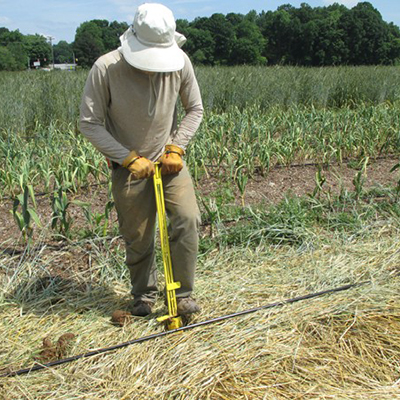
 Organic no-till and mulching systems are a huge time saver on our farm. They’ve allowed us to increase production while reducing labor on our six acres of vegetable production. This spring was our easiest year yet even though an illness in April made it difficult to leave the house. I owe the time savings to the roller crimper.
Organic no-till and mulching systems are a huge time saver on our farm. They’ve allowed us to increase production while reducing labor on our six acres of vegetable production. This spring was our easiest year yet even though an illness in April made it difficult to leave the house. I owe the time savings to the roller crimper. 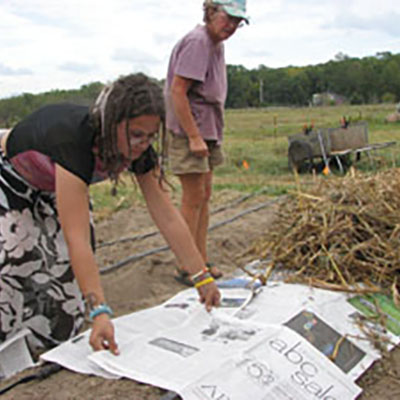
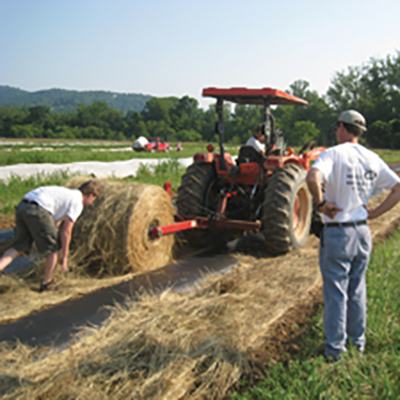


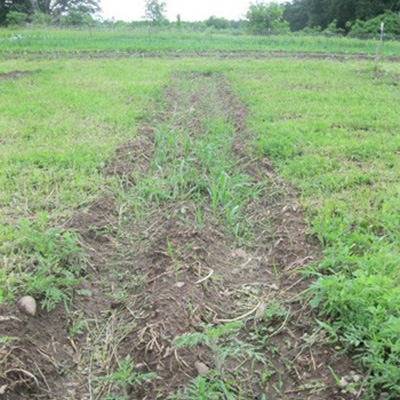
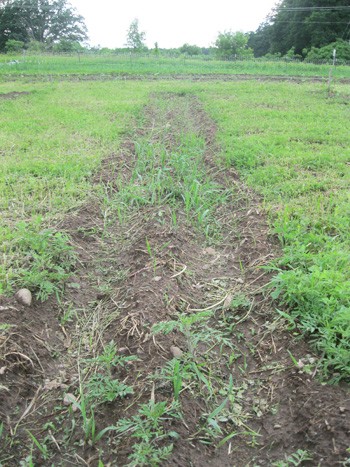 It’s no surprise that Quackgrass (Elymus repens) is also known as “The Devil’s Grass.” Thick mats of quackgrass can choke out crops and gardens alike. It encroaches from afar and grows back again and again after cutting and pulling. Rhizomes (underground stems) of this tough perennial grass can burrow as deep as eight inches in loose soil and grow over an inch per day, reaching lengths in excess of 10 feet. Broken bits of rhizomes can grow into entirely new plants, and disturbance often triggers dormant growth nodes to sprout new blades of grass. Quackgrass can dishearten even seasoned growers as a seemingly insurmountable problem.
It’s no surprise that Quackgrass (Elymus repens) is also known as “The Devil’s Grass.” Thick mats of quackgrass can choke out crops and gardens alike. It encroaches from afar and grows back again and again after cutting and pulling. Rhizomes (underground stems) of this tough perennial grass can burrow as deep as eight inches in loose soil and grow over an inch per day, reaching lengths in excess of 10 feet. Broken bits of rhizomes can grow into entirely new plants, and disturbance often triggers dormant growth nodes to sprout new blades of grass. Quackgrass can dishearten even seasoned growers as a seemingly insurmountable problem. 